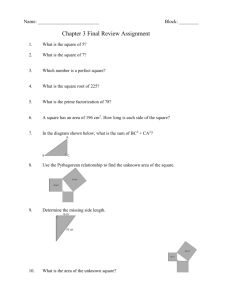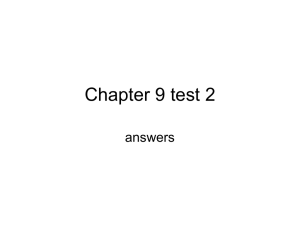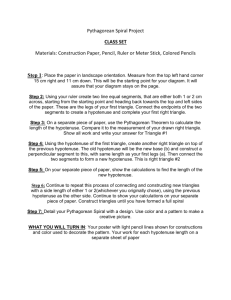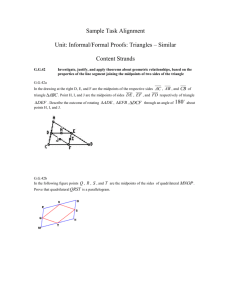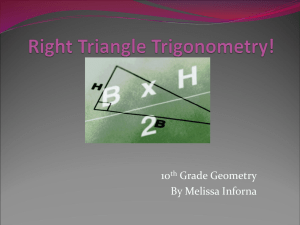Cuboctahedron - Steven Prascius`s e
advertisement
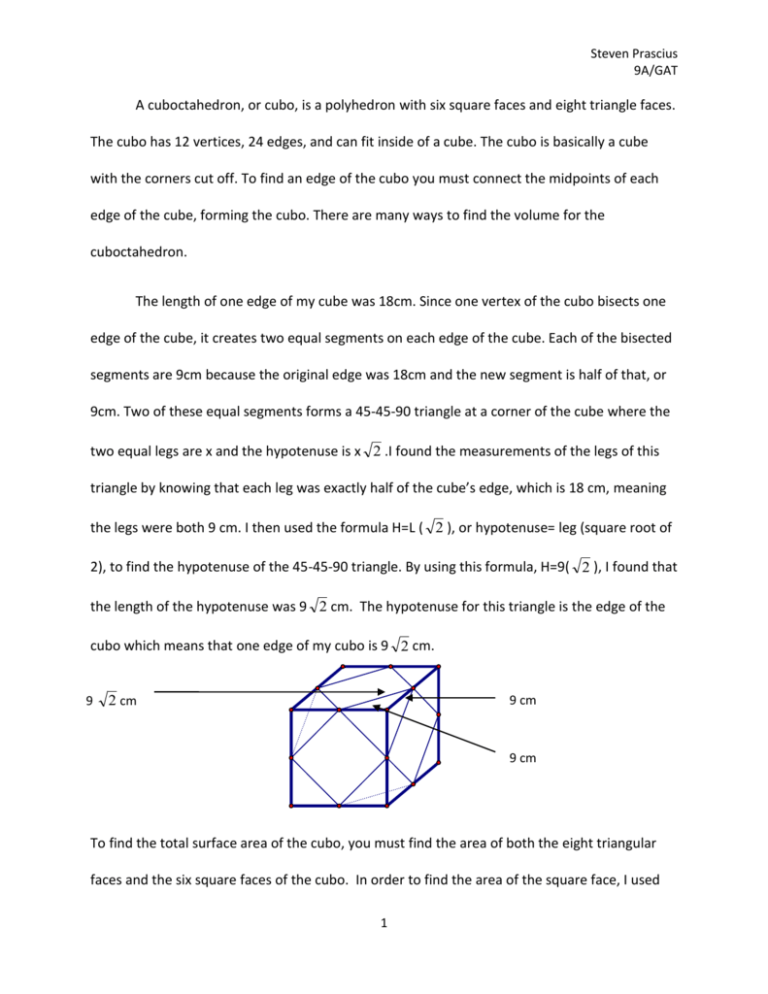
Steven Prascius 9A/GAT A cuboctahedron, or cubo, is a polyhedron with six square faces and eight triangle faces. The cubo has 12 vertices, 24 edges, and can fit inside of a cube. The cubo is basically a cube with the corners cut off. To find an edge of the cubo you must connect the midpoints of each edge of the cube, forming the cubo. There are many ways to find the volume for the cuboctahedron. The length of one edge of my cube was 18cm. Since one vertex of the cubo bisects one edge of the cube, it creates two equal segments on each edge of the cube. Each of the bisected segments are 9cm because the original edge was 18cm and the new segment is half of that, or 9cm. Two of these equal segments forms a 45-45-90 triangle at a corner of the cube where the two equal legs are x and the hypotenuse is x 2 .I found the measurements of the legs of this triangle by knowing that each leg was exactly half of the cube’s edge, which is 18 cm, meaning the legs were both 9 cm. I then used the formula H=L ( 2 ), or hypotenuse= leg (square root of 2), to find the hypotenuse of the 45-45-90 triangle. By using this formula, H=9( 2 ), I found that the length of the hypotenuse was 9 2 cm. The hypotenuse for this triangle is the edge of the cubo which means that one edge of my cubo is 9 2 cm. 9 9 cm 2 cm 9 cm To find the total surface area of the cubo, you must find the area of both the eight triangular faces and the six square faces of the cubo. In order to find the area of the square face, I used 1 Steven Prascius 9A/GAT the formula A= (B) (H), or Area= (Base) (Height). Since each edge of my cubo was 9 2 cm, the formula was A= (9 2 ) (9 2 ), which comes out to equal 81 4 , or 162 cm2. The area for one of the square faces of my cubo is 162 cm2. To find the area of all the square faces, I then multiplied the area of one square face, 162 cm2, by six because of the total six square faces. This came out to 972 cm2. The total surface area of the square faces is 972 cm2. I then found the area of the triangular face of my cubo. In order to do this I had to find the height of the triangular face. The triangle face is an equilateral triangle, which means it can be divided into two 30-60-90 triangles. The base of the 30-60-90 triangle is x, the hypotenuse is 2x and the other leg, or height, is x 3 . Since the hypotenuse is 9 2 cm, the base of the triangle is 9 2 divided by two, or 4.5 2 cm. Therefore the height of the triangle is 4.5 2 times 3 , or 4.5 6 cm. I then used the triangle area formula A= 1/2(B) (H), or Area=one half (Base) (Height), to find the area of the triangle. This comes out to be A= 1/2(9 2 ) (4.5 6 ) which equals 81 3 cm2. From here I multiplied the area of one triangular face, 81 3 cm2, by eight because of the eight triangular faces. This came out to equal 648 3 cm2. The total surface area for the triangular faces is 648 3 cm2. 9 2 cm 4.5 6 cm 9 2 cm 2 Steven Prascius 9A/GAT The total surface area of the cubo is the sum of all the faces, which is the total surface area of the square faces added to the total surface area of the triangular faces, which equals 972 cm 2 + 648 3 cm2. The total surface area for the whole cubo is 972 cm2 + 648 3 cm2. In Case 1 I had to find the dimensions and volume for the corner pyramid of the cubo. I found the dimensions of the corner pyramid by using the formula for a 45-45-90 triangle where the legs are x and the hypotenuse is x 2 . Since the sides of the base are the edges of the cubo, I knew they each were 9 2 cm. The three triangles around the base are 45-45-90 triangles so each leg is 9 cm because the hypotenuse is the edge of the cubo, which is 9 2 cm, and the formula for a 45-45-90 triangle says that legs are x while hypotenuse is x 2 , meaning the two legs of the 45-45-90 triangle are each 9 cm. s s s 9 2 cm 9 cm The volume of the pyramid can be found by using the formula V=1/3 (area of base) (Height). In order to use this formula, I had to find the area of the base. I used the 45-45-90 triangle formula where hypotenuse is x 2 , and legs are x. Both of the legs are 9 cm because the hypotenuse was 9 2 cm. The formula for area is A=1/2 (B) (H), or Area= one half (base) (height), which was 1/2 (9) (9), or 40.5 cm2. Then I found the height of the pyramid was 9 cm because the corner pyramid is a right triangle, making the slant height of 9cm the height. I then plugged in the area and the height into the volume formula V=1/3 (area of base) (Height) to get 3 Steven Prascius 9A/GAT V=1/3 (40.5) (9 cm), or 121.5 cm2. 121.5 cm2 is the volume of the corner pyramid. Then to get the the total volume of the cubo, I had to find the total volume of the cube. To get this volume I used the formula V=Ab (H), or Volume=Area of the base (Height). The area of the base of the cube was 18 cm multiplied by 18 cm because each edge of the cube was 18 cm. This came out to equal 324 cm2, which then is put into the volume formula to get v= 324(18), or 5832 cm3. Then to get the volume of the cubo I had to subtract 8 times the volume of the corner pyramid by the volume of the entire cube because there are eight triangular corners. So, the volume of the cubo was 5832 cm3-(121.5 cm3)8, which equals 4860 cm3. The total volume of my cubo is 4860 cm3. Corner Pyramid In Case 2 I had to find the dimensions of the square prism and rectangular pyramid. The square prism is the center piece of the cubo, meaning it has a height of 18 cm because it stretches from the top of the cube down to the bottom. This means it is the same length as one of the cube’s edges. The base of the prism is 9 2 cm because it is the square face of the cubo, meaning it has edges of 9 2 cm. The base is a square so, I used the formula A=B (H), or Area= Base (Height) to find the area. Since all sides of the square are the same, the area was A= 9 2 (9 2 ), or 162 cm2. The height of the prism was 18 cm so I used the formula V= (Ab) (H) to find 4 Steven Prascius 9A/GAT volume. This came out to be V= (162) (18), or 2916 cm3. The volume of the square prism is 2916 cm3. Square Prism 18 cm 9 2 cm The rectangular pyramid’s base is connected to the lateral sides of the square prism. Therefore the base has a height 18 cm and a base of 9 2 cm. To find the area of the base I used the formula A=B (H), or Area= Base (Height). I plugged my height of 18 cm and my base of 9 2 cm in the area formula to get the area of 162 2 cm2. To find the height of the pyramid, I used Pythagoreans theorem, which is a2+b2=c2. Before I used that, though, I had to find the height of the equilateral triangles that make up two parts of the rectangular pyramid. Two of the triangles are equilateral triangles with side lengths of 9 2 cm, and to find the height of these triangles I used the 30-60-90 triangle formula, were the hypotenuse is 2x, base is x, and height is x 3 . When I divided the triangle into two parts the base was 4.5 2 cm, hypotenuse was 9 2 cm, and height was 4.5 6 cm. The two other two triangles were 45-45-90 triangles when I divided them in half, where the legs are x and the hypotenuse is x 2 . This means that both legs are 9 cm because they are half of the base height, which 5 Steven Prascius 9A/GAT is 18 cm; this means that the hypotenuse is 9 2 cm. After I found my height and dimensions, I used the Pythagorean Theorem, where a2and b2 are the legs, and c2 is the hypotenuse. C2 2 B Rectangular pyramid A2 The hypotenuse of the triangle would be the height of the equilateral triangle. One of the legs would be half the measure of the height of the base, and the other leg would be the height of the whole pyramid. My hypotenuse was 4.5 6 cm, my one leg was 9 cm, and the other leg is b2 because it is the height I am trying to find. These values make 92+b2=4.5 6 2, which simplifies to 81+b2=121.5, then to b2=40.5, then b= 20.25 * 2 , and finally to b=4.5 2 . The height of the pyramid is 4.5 2 cm. After finding the height I was able to use the volume formula v= 1/3(Ab) (h), or Volume=one third (Area of base) (height of the pyramid), to find the volume of the pyramid, which is V=1/3(162 2 ) (4.5 2 ), or 486 cm3. Since there are four rectangular pyramids that make up the cubo in case 2, I had to multiply the volume of one pyramid by four, which is 1944 cm3. The volume for all four rectangular pyramids is 1944 cm3. To find the volume of the entire cubo, I had to add the volume of the square prism to the total volume of all the rectangular prisms. This would be 2916 cm3+ 1944 cm3, which equals 4860 cm3. The volume of the cubo is 4860 cm3. 6 Steven Prascius 9A/GAT 9 2 cm b a 9 2 cm a 18 cm 18 cm 9 2 cm In Case 3 I had to find the dimensions of the tetrahedron, and the regular square pyramid. The Tetrahedron is one of the triangular faces of the cubo, and is made up of four equilateral triangles. Since the base is the triangular face of the cubo, its edges are 9 2 cm, and because it is made up of four equilateral triangles all sides are 9 2 cm. The area of the base can be found by using the 30-60-90 triangle formula where the base is x, hypotenuse is 2x, and the height is x 3 . When I divide the base triangle in half I get 4.5 2 cm for the base length, 9 2 cm for the hypotenuse, and 4.5 6 cm for the height. Side 9 2 cm H 4.5 6 cm 4.5 2 cm Then to find the area of the base I used the formula A=1/2 b (h), or Area=one half base (height), which came out to be A=1/2 (9 2 ) (4.5 6 ), or 40.5 3 cm2. To find the height of the tetrahedron I used the 7 Steven Prascius 9A/GAT formula H=1/3(edge) 6 , or height of tetrahedron=one third (one edge) (square root of six), to get a height of H=1/3(9 2 ) 6 , or 6 3 cm. Then I plugged in the height of tetrahedron, 6 3 cm, and the area of the base, 40.5 3 cm2, into the formula v=1/3(Ab) (h), or volume=one third (area of base) (height of tetrahedron), to get a volume of 243 cm3. The volume of the tetrahedron is 243 cm3. The regular square pyramid is the square base of the cubo, meaning the base has an edge length of 9 2 cm. All of its edges are 9 2 cm because the four triangles that are connected to the square base are equilateral triangles. To find the area of the square base I used the formula A=b (h), or area= base (height), to get A= 9 2 (9 2 ), or 162 cm2. To find the height I had to use the Pythagorean Theorem, but first I had to find the height of the triangle sides. I did this by using the 30-60-90 triangle formula, where the base is x, hypotenuse is 2x, and height is x 3 . When I divided the equilateral triangle in half I found 4.5 2 cm to be the base, 9 2 cm to be the hypotenuse, and the height to be 4.5 6 cm. I then put the height and one leg, which is 4.5 2 cm or half of base edge, into the Pythagorean Theorem which came out to be 4.5 2 2+b2=4.5 6 , which simplifies to 40.5+b2=121.5, then to b= 81 , and finally to b=9. The height of the regular square pyramid is 9 cm. To find the volume I used the formula V=1/3(Ab) (h), which came to equal V=1/3(162) (9), or 486 cm3. The volume for the regular square pyramid is 486 cm3. a 9 2 cm a 9 2 cm Height 9cm Tetrahedron Height 6 3 cm 8 Regular square pyramid Steven Prascius 9A/GAT To find the volume of the entire cubo using tetrahedrons and regular square pyramids, I multiplied the volume of the tetrahedron by eight and the volume of the regular square pyramid by six because the cubo has six square faces and eight triangular faces. When I did this I got (243)8+486(6), or 4860 cm3. The total volume of the cubo is 4860 cm3. Regular square pyramid Tetrahedron A cuboctahedron, or cubo, is a polyhedron with eight triangular faces and six square faces. The total surface area of the cubo was 972 cm2 + 648 3 cm2, and the volume of the cubo was 4860 cm3. Throughout this project I learned that it does not matter which method you use to find the volume of the cubo because you will always get the same answer. I came across mathematical errors while trying to find many of the volumes, which threw off my whole answer. As I have learned, there are many ways to find the volume of a cuboctahedreon. 9
